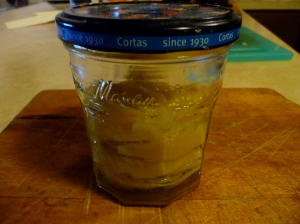In 12th-century Egypt, a doctor named Ibn Jumay stood outside his clinic, watching a funeral bier carrying a cloth-covered body pass by on the way to the burial site.
Something was not right. The feet poking out beyond the burial shroud were not flat but upright. Ibn Jumay knew that was a sure sign of life.
Sure enough, the man heading for burial was not dead. Rather, he was suffering from a cataleptic attack, a condition causing muscular rigidity and the appearance of death.
After Ibn Jumay revived him, many people thought the doctor had not only saved the man from being buried alive but had actually brought a dead man back to life! As you can imagine, Ibn Jumay’s reputation grew to mythic proportions.

I couldn't find any pictures of Ibn Jumay, but he might have looked somewhat like his more famous colleague, Maimonides, pictured here. Both were physicians to the Egyptian sultan, Saladin.
So what does this have to do with lemons?
Well, besides being one of the more famous physicians of his time and writing a frequently consulted medical compendium, Ibn Jumay wrote “On Lemon, its Drinking and Use,” the oldest and longest lasting homage to lemons. It was a kind of medical cookbook, recommending various parts and preparations of lemon for restoring health.
And it included the first known published recipe for preserved lemons, which, it’s been said, “all subsequent writers have copied.”
The 12th century instructions for cutting and salting lemons and letting them ferment for weeks are virtually the same as found in modern cookbooks, such as those by the great Mediterranean-food experts, Claudia Roden and Paula Wolfert.
After washing four lemons, cut each one into quarters end to end, but not the whole way through, so the pieces are still attatched at the ends.

- Stuff each opening with plenty of salt, and put the lemons in a glass jar, squashing them together with a wooden spoon. Add fresh lemon juice from another 4 or 5 lemons (it should nearly cover the salted lemons).
- Cover the jar tightly and let the lemons ripen at room temperature for 30 days, shaking the jar each day to redistribute the salt and juice. (In a few days, the salt will draw out enough juice to cover the lemons).
As the lemons ferment, the growth of bacteria and yeasts softens their rinds and changes the aroma from bright and sharp to rich and rounded. Preserved lemons lend a fine perfume to distinctive savory dishes of the Middle East and North Africa. They’re also great chopped up in a tuna salad or spinach salad….
Usually only the skin of preserved lemons is eaten; the pulp is scooped out and thrown away. Paula Wolfert has this to say about using preserved lemons:
Always rinse the lemons before using to remove any excess salt and use sparingly in cooking–the flavor of preserved lemons is very intense and a little goes a long way.
Put a smaller lid on top of the lemons to keep them under the water
Claudia Roden has a quicker way to make preserved lemons, by boiling them in brine. She says this “unorthodox” method gives good results in 4 days and the lemons last for months. You make 8 superficial vertical incisions into the lemon skin, then put the lemons in a pan of salted water (8 tablespoons salt for 8 lemons) to cover.
With a smaller lid on top to keep the lemons from floating to the top, boil for about 25 minutes, or until the peels are very soft. When cool enough to handle, scoop out the flesh, pack the skins in a glass jar and cover with olive oil or vegetable oil.
Ready to use in just four days. I keep them in the fridge. Hmmm, I think I should have made more.





Stunning… kinda cool issue. I will write about it too.
Hi Toby, this is a very nice piece. I was wondering what your sources were for info on Ibn Jumay and the lemon. Do you know of a translation of the treatise?
Best wishes,
Alasdair
Thanks, Alasdair. Some of Ibn Jumay’s treatise is translated in the 1938 classic, “Heperides: A History of the Culture and Use of Citrus Fruits” by Samuel Tolkowsky. I used some other sources for information about him as well, including National History of Medicine at http://www.nlm.nih.gov/hmd/arabic/bioI.html and Joel Kraemer’s book “Maimonides.”
Toby